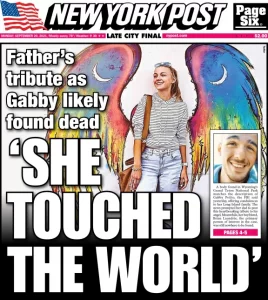Editor’s Note: Please note that nothing in this commentary is intended to minimize the violence perpetrated against Gabby Petito. But there are significant news coverage issues brought up by this case that I think need to be discussed.
Ms. Petito had come to some level of prominence as a “van life” Instagrammer – attractive young people who post photos of themselves traveling around the country and documenting their travels through social media such as Instagram and YouTube. The following video (assuming it stays up) gives Petito’s and her boyfriend Brian Laundrie’s image of themselves on the road.
The trip started in June of 2021 and Petito presented a positive view of their trip through her social media. Then, on Aug.12, the couple had an encounter with the Moab, Utah police who reported them as having “some sort of altercation.” On Aug. 30th, CNN reports that Petito’s family had their last communication from Gabby, supposedly from the area of Yosemite National Park.
Throughout September, Petito’s family reached out to Laundrie’s family, trying to figure out where Gabby had gone, but they heard nothing from either Brian or his family. Laundrie reportedly disappeared from his family’s home on September 14.
A body identified as Petito’s was found in the Bridger-Teton National Forest in Wyoming on Sept. 21, and an autopsy led to her death being classified as a homicide. Laundrie is being sought as a “person of interest” in the case.
American news media have a long history of paying more attention to crime stories that deal with conventionally attractive, wealthy, white women and girls than to those that deal with women and girls of color or who are in poverty.
Consider the story of Casey Anthony. The attractive, young, white mother was accused of murdering her two-year-old daughter. During her trial in 2011, the news media, especially cable television, was obsessed with the case. When Anthony was found not guilty, Facebook, Twitter, and other social media sites were filled with outraged comments about the verdict. In addition, talk show hosts such as Nancy Grace seemed to be obsessed with the case.
Five years after the court acquitted Anthony, Google News still featured more than 202,000 links to news stories connected to the case. On the other hand, a 2016 Google search for Jhessye Shockley, a five-year-old African American girl from Arizona who disappeared in 2011, only turned up 341 news stories, most connecting to the 2015 conviction of her mother in Jhessye’s death.
Keith Woods, an expert on diversity issues who has worked for both the Poynter Institute (a journalism think tank) and NPR, says stories about minority women tend to receive less attention because reporters are more likely to report about people they see as being like themselves. And since most newsrooms tend to be disproportionately white and middle class, the disappearance of a white woman is seen as a bigger story. This control over which stories are reported means that the public at large is not aware that African American women are disproportionately more likely to disappear than white women.
And so we see the same pattern playing out once again with the the Gabby Petito, with perhaps a few 2020 factors at play.
Ja’han Jones, who blogs for MSNBC, notes that while the “cinematic qualities” of the story and the high level of social media interest in the case accounts for some of the reason the Petito story has been so big, the main explanation is that journalists suffer from “missing white woman syndrome,” a term first used by the late, great news anchor Gwen Ifill during a 2004 journalism conference.
Jones writes that while black children go missing at a higher rate than white children do, their disappearances rarely break into the national news:
Racial disparity in missing persons cases is an absolutely real phenomenon, according to the evidence. A 2015 study found Black children account for roughly 35 percent of missing children’s cases, but they were only mentioned 7 percent of the time in media coverage about missing children.
The tabloid New York Post, in noting on the disparity of coverage ran a list, with photos, of a number of missing people of color who have gotten little of the coverage given to the Petito case.
Critics claim 'missing white woman syndrome' has overshadowed these missing persons cases https://t.co/jwiyecUwCF pic.twitter.com/8tUtwrp8K2
— New York Post (@nypost) September 22, 2021
(While scrolling to find this tweet, I went past at least five tweets from the NY Post on the Petito case.)
And here are the covers of the NY Post from the last two days:

NY Post, 9/20/21

NY Post 9/21/21
As I started this saying, nothing I’ve written here is to imply that Gabby Petito’s death is unworthy of coverage. It is absolutely a tragedy with a large human interest component. But just as we remember that Gabby’s life matters, so we must also remember that so do those of women and children of color.
